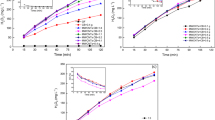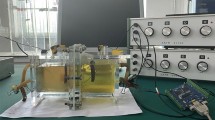Abstract
The anode electrode of microbial fuel cell (MFC) is the key component to determine its power generation performance because it is the habitat and electron transfer center of the electricity-producing microorganisms. Carbon-based anodes have been confirmed to improve MFC performance. Its large surface area, excellent conductivity and low cost make it very suitable for electrode materials used in MFC. However, the low biocompatibility and instability of common carbon-based materials restrict their practical application in MFC. In this work, a bimetal oxide MnFe2O4 was prepared and used to modify carbon felt anode by a simple drop coating method. The influence of the amount of MnFe2O4 material on the performance of MFC was systematically studied. The results showed that the power density of the carbon felt anode with a MnFe2O4 modified amount of 1 mg/cm2 increased by 66.9% compared with the unmodified anode. Meanwhile, the MFC cycle using MnFe2O4 modified anode was more stable. After 6 months of long-term operation, the power density reached 3836 mW/m2. The anode modified by MnFe2O4 has capacitance characteristics, good biocompatibility and fast electron transmission rate, which significantly improves the power generation performance of MFC. In addition, the use of a simple drop coating method to prepare electrodes can reduce the difficulty of electrode fabrication and the cost of MFC, laying a certain foundation for the industrialization of MFC.











Similar content being viewed by others
Availability of data and material
The datasets generated during and/or analysed during the current study are available from the corresponding author on reasonable request.
References
Hernandez-Fernandez FJ, De Perez Los Rios A, Salar-Garcia MJ, Ortiz-Martinez VM, Lozano-Blanco LJ, Godinez C, Tomas-Alonso F, Quesada-Medina J (2015) Recent progress and perspectives in microbial fuel cells for bioenergy generation and wastewater treatment. Fuel Process Technol 138:284–297
Santoro C, Arbizzani C, Erable B, Ieropoulos I (2017) Microbial fuel cells: from fundamentals to applications. A Rev J Power Sources 356:225–244
Slate AJ, Whitehead KA, Brownson DAC, Banks CE (2019) Microbial fuel cells: an overview of current technology. Renew Sustain Energy Rev 101:60–81
Oliveira VB, Simoes M, Melo LF, Pinto AMFR (2013) Overview on the developments of microbial fuel cells. Biochem Eng J 73:53–64
Do MH, Ngo HH, Guo WS, Liu Y, Chang SW, Nguyen DD, Nghiem LD, Ni BJ (2018) Challenges in the application of microbial fuel cells to wastewater treatment and energy production: a mini review. Sci Total Environ 639:910–920
Kumar GG, Sarathi VGS, Nahm KS (2013) Recent advances and challenges in the anode architecture and their modifications for the applications of microbial fuel cells. Biosens Bioelectron 43:461–475
Tang J, Chen S, Yuan Y, Cai X, Zhou S (2015) In situ formation of graphene layers on graphite surfaces for efficient anodes of microbial fuel cells. Biosens Bioelectron 71:387–395
Wei J, Liang P, Huang X (2011) Recent progress in electrodes for microbial fuel cells. Bioresource Technol 102:9335–9344
Yu Y, Guo CX, Yong Y, Li CM, Song H (2015) Nitrogen doped carbon nanoparticles enhanced extracellular electron transfer for high-performance microbial fuel cells anode. Chemosphere 140:26–33
Sonawane JM, Yadav A, Ghosh PC, Adeloju SB (2017) Recent advances in the development and utilization of modern anode materials for high performance microbial fuel cells. Biosens Bioelectron 90:558–576
Hindatu Y, Annuar MSM, Gumel AM (2017) Mini-review: anode modification for improved performance of microbial fuel cell. Renew Sustain Energy Rev 73:236–248
Nakamura R, Kai F, Okamoto A, Newton GJ, Hashimoto K (2009) Self-constructed electrically conductive bacterial networks. Angew Chem Int Ed 48:508–511
Okamoto A, Hashimoto K, Nakamura R (2012) Long-range electron conduction of Shewanella biofilms mediated by outer membrane C-type cytochromes. Bioelectrochemistry 85:61–65
Park DH, Zeikus JG (2003) Improved fuel cell and electrode designs for producing electricity from microbial degradation. Biotechnol Bioeng 81:348–355
Mehta T, Coppi MV, Childers SE, Lovley DR (2005) Outer membrane c-type cytochromes required for Fe(III) and Mn(IV) oxide reduction in Geobacter sulfurreducens. Appl Environ Microb 71:8634–8641
Richter K, Schicklberger M, Gescher J (2012) Dissimilatory reduction of extracellular electron acceptors in anaerobic respiration. Appl Environ Microb 78:913–921
Lowy DA, Tender LM, Zeikus JG, Park DH, Lovley DR (2006) Harvesting energy from the marine sediment-water interface II-Kinetic activity of anode materials. Biosens Bioelectron 21:2058–2063
Pandit S, Khilari S, Roy S, Pradhan D, Das D (2014) Improvement of power generation using Shewanella putrefaciens mediated bioanode in a single chambered microbial fuel cell: effect of different anodic operating conditions. Bioresource Technol 166:451–457
Zhang C, Liang P, Jiang Y, Huang X (2015) Enhanced power generation of microbial fuel cell using manganese dioxide-coated anode in flow-through mode. J Power Sources 273:580–583
Peng X, Yu H, Wang X, Zhou Q, Zhang S, Geng L, Sun J, Cai Z (2012) Enhanced performance and capacitance behavior of anode by rolling Fe3O4 into activated carbon in microbial fuel cells. Bioresource Technol 121:450–453
Zhou S, Tang J, Yuan Y (2015) Conduction-band edge dependence of carbon-coated hematite stimulated extracellular electron transfer of Shewanella oneidensis in bioelectrochemical systems. Bioelectrochemistry 102:29–34
Peng X, Yu H, Ai L, Li N, Wang X (2013) Time behavior and capacitance analysis of nano-Fe3O4 added microbial fuel cells. Bioresource Technol 144:689–692
Zeng L, Zhang W, Xia P, Tu W, Ye C, He M (2018) Porous Ni0.1Mn0.9O1.45 microellipsoids as high-performance anode electrocatalyst for microbial fuel cells. Biosens Bioelectron 102:351–356
Munjal M, Tiwari B, Lalwani S, Sharma M, Singh G, Sharma RK (2020) An insight of bioelectricity production in mediator less microbial fuel cell using mesoporous Cobalt Ferrite anode. Int J Hydrogen Energ 45:12525–12534
Yamaguchi NU, Bergamasco R, Hamoudi S (2016) Magnetic MnFe2O4-graphene hybrid composite for efficient removal of glyphosate from water. Chem Eng J 295:391–402
Bhargava G, Gouzman I, Chun CM, Ramanarayanan TA, Bernasek SL (2007) Characterization of the “native” surface thin film on pure polycrystalline iron: a high resolution XPS and TEM study. Appl Surf Sci 253:4322–4329
Zhu, X., H. Zhao, X. Niu, T. Liu, L. Shi, and M. Lan (2016) A comparative study of carbon nanotube supported MFe2O4 spinels (M = Fe, Co, Mn) for amperometric determination of H2O2 at neutral pH values. MICROCHIM ACTA. 183:2431–2439. https://doi.org/10.1007/s00604-016-1887-3
Deng L, Guo S, Liu Z, Zhou M, Li D, Liu L, Li G, Wang E, Dong S (2010) To boost c-type cytochrome wire efficiency of electrogenic bacteria with Fe3O4/Au nanocomposites. Chem Commun 46:7172
Peng X, Yu H, Wang X, Gao N, Geng L, Ai L (2013) Enhanced anode performance of microbial fuel cells by adding nanosemiconductor goethite. J Power Sources 223:94–99
Zhong D, Liu Y, Liao X, Zhong N, Xu Y (2018) Facile preparation of binder-free NiO/MnO2-carbon felt anode to enhance electricity generation and dye wastewater degradation performances of microbial fuel cell. Int J Hydrogen Energ 43:23014–23026
Cai W, Lai T, Dai W, Ye J (2014) A facile approach to fabricate flexible all-solid-state supercapacitors based on MnFe2O4/graphene hybrids. J Power Sources 255:170–178
Khilari S, Pandit S, Varanasi JL, Das D, Pradhan D (2015) Bifunctional manganese ferrite/polyaniline hybrid as electrode material for enhanced energy recovery in microbial fuel cell. Acs Appl Mater Inter 7:20657–20666
Peng X, Chu X, Wang S, Shan K, Song D, Zhou Y (2017) Bio-power performance enhancement in microbial fuel cell using Ni-ferrite decorated anode. Rsc Adv 7:16027–16032
Zhang Y, Jiang Z, Liu Y (2015) Application of electrochemically active bacteria as anodic biocatalyst in microbial fuel cells. Chinese J Anal Chem 43:155–163
Li D, Huang Y, Li J, Li L, Tian L, Yu H (2017) Electrochemical activities of Geobacter biofilms growing on electrodes with various potentials. Electrochim Acta 225:452–457
Acknowledgments
The authors sincerely acknowledge the financial support from the National Natural Science Foundation of China (No. 21961028, No. 21663020) and the Science and Technology Support Program of Ningxia Province of China (NX 2015076).
Funding
This study was funded by National Natural Science Foundation of China (No. 21961028, No. 21663020) and the Science and Technology Support Program of Ningxia Province of China (NX 2015076).
Author information
Authors and Affiliations
Contributions
All authors contributed to the study conception and design and all authors commented on previous versions of the manuscript. All authors read and approved the final manuscript.
Corresponding author
Ethics declarations
Conflicts of interest/Competing interests
Authors have no conflict of interest to declare.
Additional information
Publisher's Note
Springer Nature remains neutral with regard to jurisdictional claims in published maps and institutional affiliations.
Rights and permissions
About this article
Cite this article
Xue, P., Jiang, S., Li, W. et al. Bimetallic oxide MnFe2O4 modified carbon felt anode by drip coating: an effective approach enhancing power generation performance of microbial fuel cell. Bioprocess Biosyst Eng 44, 1119–1130 (2021). https://doi.org/10.1007/s00449-021-02511-z
Received:
Accepted:
Published:
Issue Date:
DOI: https://doi.org/10.1007/s00449-021-02511-z




